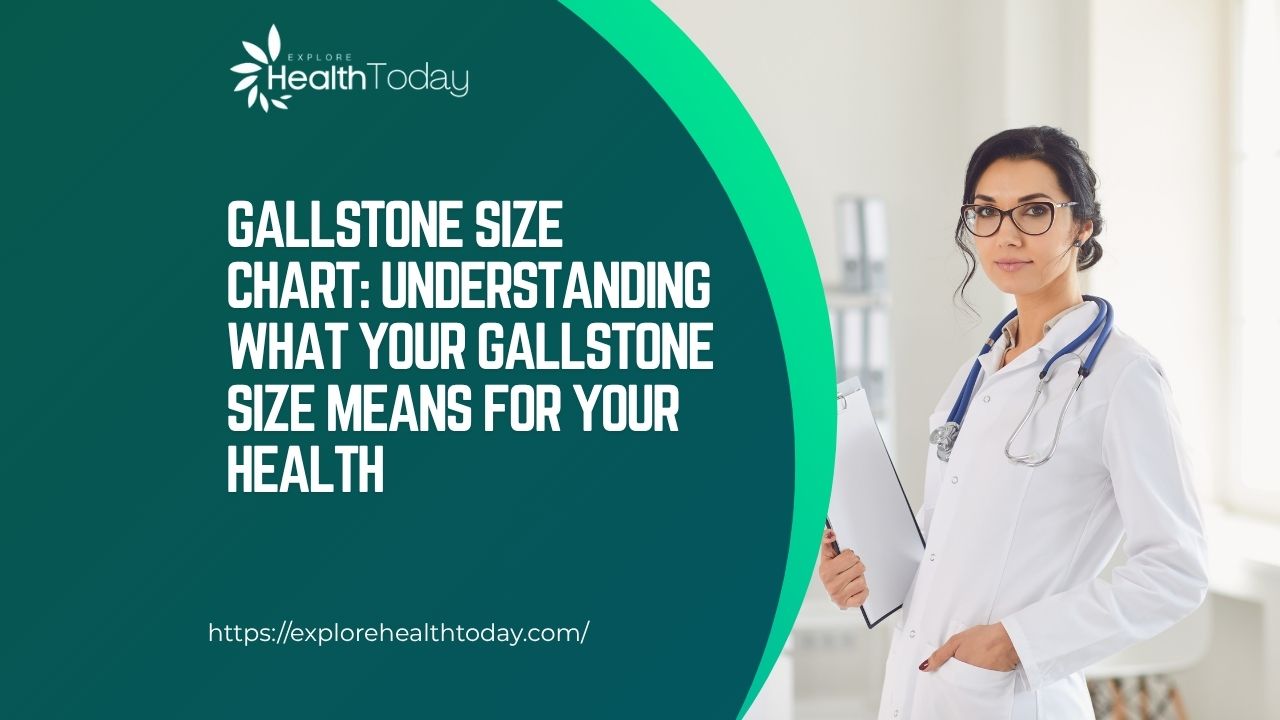Gallstones are a common but often misunderstood health issue affecting millions of Americans. If you’ve recently been diagnosed with gallstones, one of the first things you might wonder is: how big is my gallstone, and does its size really matter?
The answer is yes—gallstone size plays a significant role in determining how symptoms manifest, what treatment is recommended, and whether surgery may be necessary. That’s where a gallstone size chart comes in handy.
In this comprehensive guide, we’ll walk you through everything you need to know about gallstone sizes—from how they form to how large they can grow—and how size influences your next steps in managing this condition.
What Are Gallstones?
Gallstones are solid particles that form in the gallbladder, a small organ located beneath your liver. These stones can be made of:
- Cholesterol (the most common type in the U.S.)
- Pigment (formed from excess bilirubin)
Gallstones can vary in size from a grain of sand to as large as a golf ball. Sometimes, you might have one large gallstone—or hundreds of tiny ones.
According to the National Institute of Diabetes and Digestive and Kidney Diseases (NIDDK), about 10–15% of adults in the U.S. have gallstones, and around 1 million surgeries are performed annually to remove gallbladders due to complications.
Why Gallstone Size Matters
Small vs Large Gallstones
Gallstones are generally categorized by their diameter in millimeters (mm) or centimeters (cm). Here’s why size is important:
- Small stones may travel into the bile ducts and cause blockages, leading to acute symptoms such as gallstone pancreatitis or cholangitis.
- Larger stones are more likely to remain in the gallbladder but can irritate the gallbladder lining, causing chronic inflammation or pain (biliary colic).
Understanding your stone size helps determine:
- Whether surgery is recommended
- If non-surgical options may work
- Your risk for serious complications
Gallstone Size Chart (Common Ranges)
Here is a breakdown of gallstone sizes and what they typically mean:
| Size | Measurement | Common Description | Potential Risk/Concern |
| Very Small | < 2 mm | “Sludge” or microlithiasis | Can block small bile ducts, trigger pancreatitis |
| Small | 2–5 mm | Gravel-like | May pass into bile duct; causes acute pain |
| Medium | 6–9 mm | Pea-sized | Moderate risk for complications |
| Large | 10–20 mm | Marble-sized | Often causes chronic symptoms; surgery likely |
| Very Large | > 2 cm | Walnut or golf ball-sized | Strong indication for gallbladder removal |
Note: This chart is for informational purposes only. Always consult your physician for personalized diagnosis and treatment.
How Gallstones Are Measured
Imaging Techniques
Doctors typically identify and measure gallstones using:
- Ultrasound – the most common and non-invasive method
- CT Scan – used in more complex or emergency cases
- MRCP (Magnetic Resonance Cholangiopancreatography) – advanced imaging for bile duct stones
These imaging tools help assess the number, size, and location of stones, all of which influence your treatment plan.
Symptoms Based on Gallstone Size
Although some people never experience symptoms (a condition called “silent gallstones”), others may have severe reactions depending on stone size.
Common Symptoms
- Nausea or vomiting after eating fatty foods
- Sudden pain in the upper right abdomen
- Jaundice (yellowing of the skin or eyes)
- Bloating or gas
- Back or shoulder pain
Smaller stones may cause more immediate and sharp pain if they move into the bile ducts, while larger stones tend to cause persistent, dull pain due to inflammation or pressure.
Treatment Options Based on Gallstone Size
Treatment depends largely on size, symptoms, and overall health. Here’s how options stack up:
Observation (for Small, Asymptomatic Stones)
- Recommended if the stones are small and cause no symptoms
- Regular check-ups and dietary adjustments
- Common approach for elderly patients or those with surgical risks
Medications
- Ursodiol (ursodeoxycholic acid) can dissolve small cholesterol stones
- Takes months or even years to be effective
- Only works for certain types of stones
- Often not covered by insurance for asymptomatic cases
Surgery (Cholecystectomy)
- Laparoscopic gallbladder removal is the gold standard for symptomatic gallstones
- Typically recommended for stones larger than 1 cm, or if multiple stones are present
- Covered by most insurance plans when symptoms are documented
According to Cleveland Clinic, laparoscopic cholecystectomy has a success rate over 95% and is often done as an outpatient procedure.
Gallstone Complications by Size
Gallstones can lead to serious issues, regardless of size. However, smaller stones may be more dangerous in certain cases because they’re more likely to travel into ducts.
Potential Complications:
- Biliary obstruction
- Acute pancreatitis
- Gallbladder infection (cholecystitis)
- Jaundice
A 2024 study published by the National Library of Medicine found that stones under 5 mm were more likely to result in pancreatitis than larger ones—highlighting why “small” doesn’t always mean “safe.”
U.S. Trends and Insurance Coverage (2024–2025)
In recent years, U.S. healthcare has focused more on early detection and preventive treatment of gallbladder disease:
- More insurers now cover diagnostic ultrasounds when digestive symptoms are reported
- Telehealth consultations for gallbladder issues have expanded access, especially in rural areas
- Health savings accounts (HSAs) and FSA plans may cover gallstone medications, dietary counseling, or surgical prep
The average cost for gallbladder removal in 2025 ranges from $5,000 to $15,000, depending on your location and insurance. Most major insurers, including Medicare and Medicaid, cover the procedure when deemed medically necessary.
How to Prevent Gallstone Formation
While genetics play a role, lifestyle factors are just as important. You can reduce your risk of forming problematic stones by:
- Maintaining a healthy weight
- Avoiding rapid weight loss
- Eating a balanced, high-fiber diet
- Staying active
- Limiting saturated fats and cholesterol
A recent CDC report notes that a diet high in whole grains, fruits, and vegetables significantly lowers the risk of gallstone development.
Conclusion: Know Your Numbers with the Gallstone Size Chart
Gallstones are more than just an uncomfortable diagnosis—they’re a condition that requires awareness and often action. Understanding where your stones fall on the gallstone size chart gives you clarity about your symptoms, potential complications, and treatment options.
Whether your gallstones are small and manageable or large and symptomatic, working with a healthcare provider is key to avoiding future problems. And with insurance trends evolving and more tools available in 2025, getting the care you need is more accessible than ever.
Have you been diagnosed with gallstones? Ask your doctor about your stone size and what it means for your health. Understanding the gallstone size chart can help you make informed decisions about your treatment path.
About ExploreHealthToday.com
ExploreHealthToday.com was created to be a one-stop resource where readers can find up-to-date, well-researched articles on a variety of health topics. From nutrition and wellness to lifestyle and mental health, we strive to provide reliable information to help you make informed decisions about your well-being.
We believe that good health starts with good information, and our mission is to empower our readers with knowledge they can trust.
Visit us at ExploreHealthToday.com to learn more.





